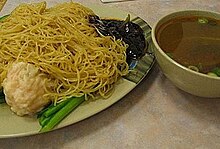
Summary
Lo mein (traditional Chinese: 撈麵/撈麪; simplified Chinese: 捞面; Cantonese Yale: lou1 min6; pinyin: lāo miàn) is a Chinese dish with noodles. It often contains vegetables and some type of meat or seafood, usually beef, chicken, pork, or shrimp. It may also be served with wontons (called húntun 餛飩/馄饨 in Mandarin), and it can also be eaten with just vegetables.
 A plate of Cantonese style lo mein | |
| Course | Main course |
|---|---|
| Place of origin | China |
| Region or state | Guangdong |
| Serving temperature | Hot |
| Main ingredients | Noodles, soy sauce, vegetables, chicken, pork, beef, shrimp |
| |
| Lo mein | |||||||||||||||||
|---|---|---|---|---|---|---|---|---|---|---|---|---|---|---|---|---|---|
| Traditional Chinese | 撈麵 | ||||||||||||||||
| Simplified Chinese | 捞面 | ||||||||||||||||
| Literal meaning | noodles | ||||||||||||||||
| |||||||||||||||||
| Alternative Chinese name | |||||||||||||||||
| Traditional Chinese | 拌麵 | ||||||||||||||||
| Simplified Chinese | 拌面 | ||||||||||||||||
| |||||||||||||||||
Etymology edit
The term lo mein comes from the Cantonese lou1 min6 (撈麵), meaning "stirred noodles".[1] The Cantonese use of the character 撈, pronounced lou1 and meaning "to stir", in its casual form, differs from the character's traditional Han meaning of "to dredge" or "to scoop out of water" in Mandarin, in which case it would be pronounced as laau4 or lou4 in Cantonese (lāo in Mandarin).[2][3] In Mandarin, the dish is called lāo miàn. In its country of origin, it is made of thin flour-and-egg noodles which are notable for their elastic texture.
Regional variations edit
Northern China edit
In northern China, bàn miàn (拌面) can refer to many other types of wheat noodles without egg, including laghman in Xinjiang.[4]
American Chinese cuisine edit
In American Chinese restaurants, lo mein is a popular take-out food and is sometimes considered synonymous with chow mein. The dish is distinct from both Cantonese lo mein and Cantonese crispy chow mein. Cantonese lo mein is stirred with a thin sauce and items such as wonton or beef brisket added on top. In contrast, U.S. lo mein noodles are usually stir-fried with a sauce made from soy sauce and other seasonings. Vegetables such as bok choy and cabbage can be mixed in and meats like roast pork, beef or chicken are often added. Shrimp lo mein, lobster lo mein, vegetable lo mein, and "house" lo mein (more than one meat) are sometimes available.[citation needed]
-
American-style lo mein
Indonesian Chinese cuisine edit
In Indonesian Chinese cuisine, lo mein is made using egg noodles or "mie hokkien".[5][6][7]
See also edit
References edit
- ^ "lo mein". Merriam-Webster Online Dictionary. Merriam-Webster Online. 2008.
- ^ 撈. 《現代標準漢語與粵語對照資料庫》 (A Comparative Study of Modern Chinese and Cantonese) (in Chinese). 香港中文大學 (Chinese University of Hong Kong). Archived from the original on 2011-07-21.
- ^ 撈. 《粵語審音配詞字庫》 (Chinese Character Database: With Word-formations Phonologically Disambiguated According to the Cantonese Dialect) (in Chinese). 香港中文大學 (Chinese University of Hong Kong).
- ^ "Uyghur Laghman | Introduction to a Tasty, Traditional Xinjiang Cuisine!". 5 May 2020.
- ^ "Yuk Cari Tahu Jenis-Jenis Mie yang Populer di Indonesia!", ilmupedia
- ^ "Bosan Mie Bakso Biasa? Yuk Coba Kelezatan Lomie", tribunnews
- ^ "Gurih Mantap! Lomie Lombok Khas Bandung Buat 'Brunch' Akhir Pekan", Detik


